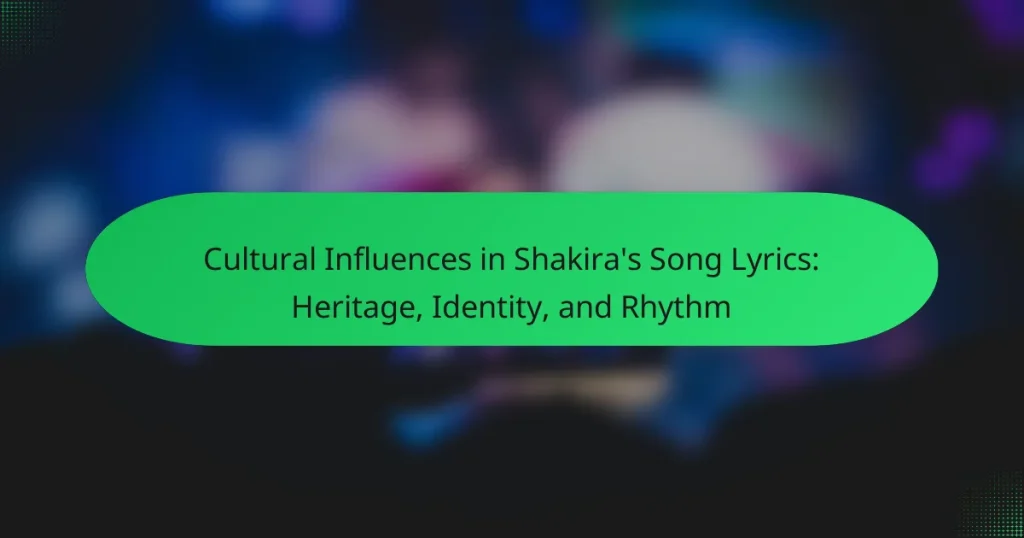Shakira is a renowned artist whose song lyrics are deeply influenced by her multicultural background, specifically her Colombian heritage and Lebanese ancestry. The article explores how her music integrates diverse cultural elements, including Latin American, Middle Eastern, and Western influences, which are reflected in her use of traditional rhythms and instruments. Key examples include the incorporation of Brazilian sounds in “La La La (Brazil 2014)” and Arabic melodies in “Ojos Así.” Additionally, the article highlights the significance of rhythm in her work, illustrating how it enhances emotional depth and connects her to her cultural roots. Overall, Shakira’s music promotes cross-cultural understanding and challenges stereotypes within the mainstream music industry.

What are the cultural influences in Shakira’s song lyrics?
Shakira’s song lyrics are influenced by a blend of Latin American, Middle Eastern, and Western cultures. Her Colombian heritage is prominent in her music, showcasing traditional rhythms and instruments. Songs like “La La La (Brazil 2014)” incorporate Brazilian influences, reflecting her connection to Latin American culture. Additionally, Shakira’s use of Arabic melodies in tracks like “Ojos Así” highlights her Lebanese ancestry. The fusion of these diverse elements creates a unique sound that resonates globally. Her lyrics often explore themes of love, identity, and social issues, drawing from her multicultural background. This rich tapestry of influences contributes to her distinctive artistic voice.
How does Shakira’s heritage shape her music?
Shakira’s heritage significantly influences her music. Her Colombian and Lebanese roots blend various musical styles. Colombian rhythms like cumbia and vallenato are prominent in her songs. Additionally, Arabic musical elements reflect her Lebanese heritage. This fusion creates a unique sound that distinguishes her from other artists. Shakira often incorporates Spanish and English lyrics, showcasing her bilingualism. Her cultural background informs her themes of love, identity, and social issues. This diverse heritage enriches her songwriting and performance style.
What specific cultural elements can be identified in her lyrics?
Shakira’s lyrics incorporate specific cultural elements such as Latin rhythms, bilingual language, and references to Colombian heritage. Latin rhythms are evident in her use of cumbia and reggaeton styles, which reflect her cultural roots. Bilingual language appears in her blending of English and Spanish, showcasing her multicultural identity. References to Colombian heritage include mentions of local traditions and landscapes, emphasizing her connection to her homeland. These elements contribute to her unique musical identity and resonate with diverse audiences.
How do her Colombian roots influence her songwriting style?
Her Colombian roots significantly influence her songwriting style. This influence manifests through the incorporation of traditional Colombian rhythms and instruments. Shakira often blends cumbia and vallenato elements into her music. These genres reflect her cultural heritage and resonate with her identity. Her lyrics frequently explore themes related to love, family, and social issues prevalent in Colombian society. Additionally, her bilingualism enriches her songwriting, allowing her to connect with diverse audiences. The authenticity of her Colombian background is evident in her passionate performances and storytelling. Overall, her roots provide a rich tapestry that informs her artistic expression.
In what ways does identity play a role in Shakira’s lyrics?
Identity plays a significant role in Shakira’s lyrics by reflecting her multicultural background. Shakira often incorporates elements from her Colombian heritage, blending Latin rhythms with pop influences. Her lyrics frequently address themes of love, self-empowerment, and cultural pride. For example, songs like “La Tortura” highlight her roots and the complexities of relationships. Additionally, she uses both Spanish and English in her music, showcasing her bilingual identity. This linguistic diversity allows her to connect with a broader audience. Shakira’s exploration of identity resonates with listeners who share similar cultural experiences. Overall, her lyrics serve as a vehicle for expressing her multifaceted identity and cultural influences.
How does Shakira express her personal identity through music?
Shakira expresses her personal identity through music by blending diverse cultural influences. She incorporates elements from her Colombian heritage, such as traditional rhythms and instruments. This fusion creates a unique sound that reflects her background. Shakira often writes lyrics in both Spanish and English, showcasing her bilingualism. Her songs frequently address themes of love, empowerment, and social issues, reflecting her values and experiences. Additionally, she draws inspiration from various musical genres, including pop, rock, and reggaeton. This eclectic approach highlights her versatility as an artist. Shakira’s performances often feature dance styles that celebrate her Latin roots, further emphasizing her identity. Through these artistic choices, she connects with a global audience while remaining true to her origins.
What themes of identity are prevalent in her songs?
Shakira’s songs explore themes of cultural identity and personal empowerment. Her lyrics often reflect her Colombian heritage, blending Latin influences with global sounds. She addresses issues of love, self-discovery, and resilience. Additionally, themes of feminism and social justice are prevalent in her work. For example, in “La Tortura,” she highlights the struggles of women in relationships. Overall, her music serves as a celebration of diverse identities, bridging cultural gaps through rhythm and storytelling.

How does rhythm contribute to the cultural influences in her lyrics?
Rhythm plays a crucial role in shaping the cultural influences in her lyrics. It reflects the diverse musical traditions that inspire her work. Shakira incorporates various rhythmic patterns from Latin, Middle Eastern, and Caribbean music. These rhythms enhance the emotional depth of her songs. They also connect her to her Colombian heritage. For example, the use of cumbia rhythms evokes traditional Colombian music. This connection strengthens her cultural identity in her lyrics. The interplay of rhythm and language creates a unique fusion that resonates with a global audience. Overall, rhythm serves as a bridge between her cultural roots and contemporary influences.
What rhythmic patterns are commonly found in Shakira’s music?
Shakira’s music commonly features a blend of Latin rhythms and pop elements. Prominent rhythmic patterns include reggaeton, salsa, and cumbia. These patterns create a vibrant and danceable sound. The use of syncopation is also notable in her songs. Syncopation adds a unique groove that engages listeners. Additionally, Shakira often incorporates traditional Middle Eastern rhythms. This reflects her diverse cultural influences. Her song “Hips Don’t Lie” exemplifies these rhythmic patterns effectively. The fusion of these elements contributes to her distinctive musical style.
How do these rhythms reflect her cultural background?
The rhythms in Shakira’s music reflect her cultural background through their incorporation of Latin and Middle Eastern influences. Her Colombian heritage is evident in the use of cumbia and vallenato rhythms. These styles are traditional in Colombia and showcase her roots. Additionally, Shakira often integrates Arabic musical elements, highlighting her Lebanese ancestry. This blend of styles creates a unique sound that celebrates her diverse identity. The rhythmic patterns used in her songs resonate with cultural significance, connecting her to her heritage. This musical fusion illustrates the rich tapestry of her cultural influences and personal history.
What impact do these rhythms have on the overall feel of her songs?
The rhythms in Shakira’s songs significantly enhance their overall feel. These rhythms create an engaging and dynamic atmosphere. They often incorporate elements from various cultural backgrounds, reflecting her heritage. This multicultural blend adds depth and richness to her music. The infectious beats invite listeners to dance and connect emotionally. For example, her use of Latin rhythms emphasizes passion and energy. This connection to her roots resonates with audiences globally. Overall, these rhythms contribute to a unique and memorable listening experience.
How do cultural influences enhance the storytelling in her lyrics?
Cultural influences enhance the storytelling in her lyrics by integrating diverse themes and narratives. Shakira draws from her Colombian heritage, incorporating local folklore and traditions. This connection adds authenticity and depth to her storytelling. For example, her song “La La La (Brazil 2014)” reflects Brazilian culture and the spirit of the World Cup. Additionally, she blends various musical styles, such as reggaeton and cumbia, enriching her lyrical expression. By weaving in elements from different cultures, her lyrics resonate with a global audience. This approach not only showcases her identity but also invites listeners to explore and appreciate cultural diversity.
What narratives are shaped by her cultural experiences?
Shakira’s cultural experiences shape narratives of identity, heritage, and empowerment. Her Colombian roots influence themes of love and social issues. The blending of Latin and Arabic rhythms in her music reflects her diverse background. Shakira often addresses cultural pride and the importance of community. Her lyrics explore the complexities of cross-cultural relationships. She uses her platform to advocate for education and children’s rights. These narratives resonate with a global audience, highlighting shared human experiences. Shakira’s work exemplifies the fusion of personal and cultural storytelling.
How does Shakira use storytelling to connect with her audience?
Shakira uses storytelling to connect with her audience by weaving personal experiences and cultural narratives into her lyrics. This approach creates relatable themes that resonate with listeners. For instance, she often incorporates elements of her Colombian heritage, reflecting her identity and cultural background. Songs like “La Tortura” and “Ciega, Sordomuda” showcase vivid imagery and emotional depth. These narratives evoke strong feelings and foster a sense of shared experience. By blending personal and cultural stories, Shakira engages her audience on multiple levels. Her storytelling transcends language barriers, making her music accessible to a global audience. This connection is reinforced by her dynamic performances, which visually represent the stories she tells.

What are the broader implications of Shakira’s cultural influences in her music?
Shakira’s cultural influences in her music highlight the fusion of diverse musical styles and traditions. This blending promotes cross-cultural understanding and appreciation. Her Colombian heritage is evident in her use of Latin rhythms and instruments. Shakira’s incorporation of Arabic influences reflects her Lebanese ancestry. This multicultural approach broadens her audience and connects various cultural groups. It also challenges stereotypes about Latin music in mainstream media. The success of her songs, like “Hips Don’t Lie,” demonstrates the global appeal of her cultural integration. Shakira’s music serves as a platform for cultural dialogue and exchange.
How has Shakira’s music impacted global perceptions of Latin culture?
Shakira’s music has significantly enhanced global perceptions of Latin culture. Her fusion of various musical styles, including Latin pop, rock, and reggaeton, showcases the diversity of Latin music. Songs like “Hips Don’t Lie” and “La La La (Brazil 2014)” achieved international acclaim, reaching audiences beyond Spanish-speaking countries. This exposure has led to a greater appreciation for Latin rhythms and sounds. Shakira’s bilingual lyrics also bridge cultural gaps, making her music accessible to a wider audience. Collaborations with global artists further amplify her influence, integrating Latin culture into mainstream music. As a result, Shakira has become a cultural ambassador, shaping how Latin heritage is viewed worldwide.
What role does her music play in cultural exchange?
Her music serves as a bridge for cultural exchange. It blends various musical styles, such as Latin, pop, and hip-hop. This fusion introduces diverse cultural elements to a global audience. Her lyrics often reflect themes of identity and heritage. They resonate with listeners from different backgrounds. Collaborations with international artists further enhance this exchange. For example, her work with artists like Wyclef Jean and Alejandro Sanz showcases cross-cultural collaboration. Such collaborations promote understanding and appreciation of different cultures. Through her music, Shakira fosters dialogue and connection among diverse communities.
What can listeners learn from Shakira’s blending of cultures in her lyrics?
Listeners can learn about the rich interplay of diverse cultural influences in Shakira’s lyrics. Her music often incorporates elements from Latin, Middle Eastern, and Western musical traditions. This blending highlights the importance of cultural identity and heritage. For instance, Shakira frequently uses Spanish and English in her songs, reflecting her Colombian roots and global appeal. Additionally, her incorporation of various musical styles, such as cumbia and rock, showcases her versatility. This cultural fusion promotes understanding and appreciation of different backgrounds. Through her lyrics, listeners gain insights into the complexities of identity in a globalized world. Shakira’s work serves as a bridge connecting various cultures, fostering dialogue and unity.
How can understanding cultural influences enhance appreciation for her music?
Understanding cultural influences can significantly enhance appreciation for her music. Cultural contexts shape the themes, rhythms, and styles present in her songs. For example, Shakira incorporates Latin rhythms and instruments, reflecting her Colombian heritage. This connection to culture allows listeners to engage with the music on a deeper level. Recognizing the cultural references in her lyrics can provide insights into her identity and experiences. Furthermore, understanding the historical and social background of her influences enriches the listening experience. This appreciation can lead to a greater emotional connection with her music. Overall, cultural understanding adds layers of meaning that resonate with diverse audiences.
What are some tips for analyzing cultural themes in song lyrics?
To analyze cultural themes in song lyrics, start by identifying key symbols and references. Look for specific cultural elements such as language, traditions, and historical events. Examine how these elements relate to the artist’s background and identity. Consider the emotional tone and imagery used in the lyrics. Analyze how the lyrics reflect societal issues or cultural narratives. Contextualize the song within its cultural and historical framework. Engage with scholarly interpretations or critiques of the song. This method enhances understanding of the cultural significance embedded in the lyrics.
The main entity of the article is Shakira’s song lyrics, which are shaped by her diverse cultural influences, including Colombian, Middle Eastern, and Western elements. The article explores how her heritage informs her music through traditional rhythms, bilingual lyrics, and themes of identity and empowerment. Specific cultural elements, such as Latin rhythms and references to Colombian traditions, are analyzed to illustrate their impact on her songwriting style and storytelling. Additionally, the article discusses the broader implications of her music in promoting cross-cultural understanding and enhancing global perceptions of Latin culture. Overall, it highlights the significance of rhythm and cultural narratives in Shakira’s work, emphasizing her role as a cultural ambassador.


